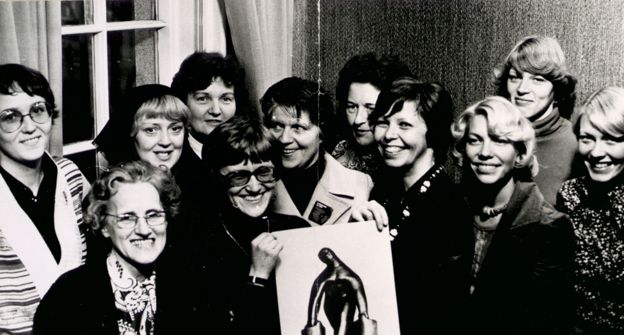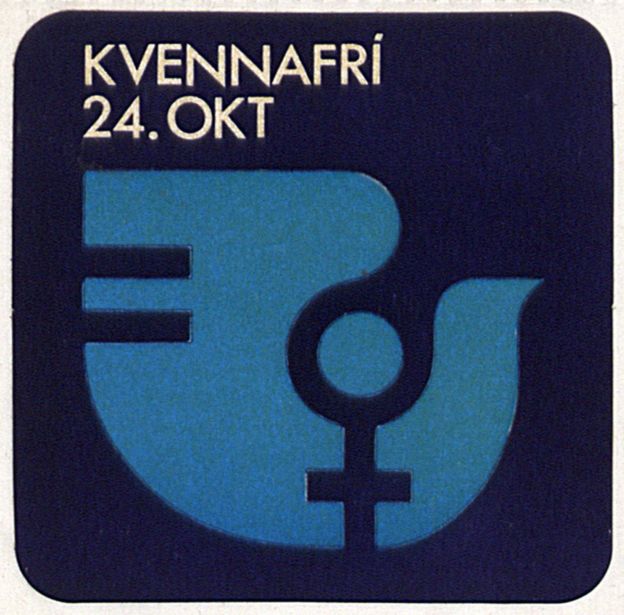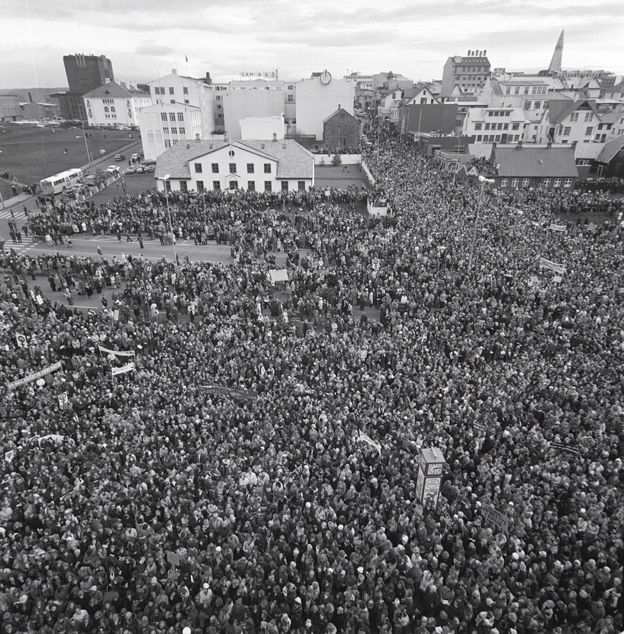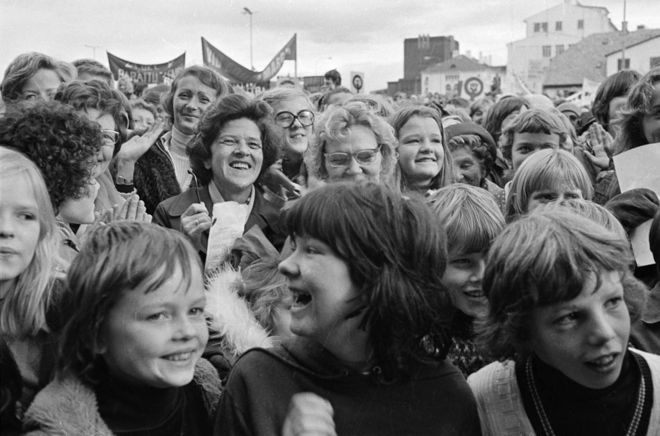A short history of the strike, or day off, by 90% of women in Iceland for equality with men on 24 October, 1975, written by Steven Johns.

Background
In the early 1970s, women in Iceland earned over 40% less than men.
1975 had been declared International Women’s Year by the United Nations. Five of the biggest women’s groups in Iceland formed a committee (pictured below) to organise commemorative events.

A radical feminist movement called the Red Stockings initially suggested a strike to protest against low pay and show the value of female labour within and outside the home.
The committee decided to call for a “day off” rather than a strike to prevent women potentially being sacked for striking and to attempt to better gain “public support” (which usually means “mainstream media support”). Supported by key Icelandic trade unions, they chose October 24 - United Nations Day - for the protest.

Sticker advertising the protest reading “Day off, October 24”
On the buildup to the event, Annadis Rudolfsdottir recalled to the Guardian:
In the days preceding the 24th it seemed that women everywhere were grouping together, drinking coffee, smoking incessantly but doing a lot of agitated talking. My granny, who was working incredibly hard in a fish factory, was not going to take the day off. But the questions raised by the women's movements whirred around her mind. Why were young men taking home higher wages than her when her job was no less physically strenuous? My mother, who was 28 and worked in a dairy, had to use all her negotiation skills to convince her boss, a hard-working woman in her 50s, that they should leave work. When my mother dropped by her boss's flat to persuade her to come to a rally that had been organised in downtown Reykjavik, she was assuaging her guilt from skiving off work by baking furiously.
Day off
On October 24, 90% of women in Iceland, in both urban and rural communities, did not go to their paid jobs or do housework or childcare at home.
As a result, many industries shut down for the day.

Newspapers were not printed since the vast majority of typesetters were women and there was no telephone service. Many schools were either closed or partially closed as the majority of teachers were women.
Flights were cancelled as flight attendants did not come to work and bank branches had to be staffed by executives as tellers took the day off.
Fish factories were also closed, with many nurseries and shops also shut or at reduced capacity.

Many employers had had to make arrangements for male employees to bring their children into work. And many shops sold out of sausages, which was a popular easy meal for families to be made either by men or by elder children many of whom were bribed by their fathers to cook.
25,000 women rallied in the capital, Reykjavik (pictured throughout this article), bringing traffic to a standstill. The numbers are even more impressive considering that the population of Iceland was only 220,000 at the time.

The stoppage lasted until midnight, at which time women workers due to be on shift returned to work.
At the office of the conservative newspaper, Morgunbladid, no women had been present during the day. When women workers returned at midnight a special shorter issue of the paper (16 instead of 24 pages) was produced which was exclusively about the strike.
While not officially a “strike” I believe it is clear that the disruptive impact the protest had meant that effectively it did constitute strike action, both in the home and at work. As employers only agree to staff taking time off if it will have a minimal impact on service delivery. However in this instance the groundswell of support for the day off made it impossible for employers to deny women’s requests.
Consequences
A year after the strike, in 1976, Iceland formed the Gender Equality Council and passed the Gender Equality Act, which outlawed gender discrimination in workplaces and schools.
In 1980, Iceland elected its first female president, Vigdis Finnbogadottir, who held office for four terms, until 1996. Famously, when Ronald Reagan was elected as US president, one young Icelandic boy was outraged: "He can't be a president - he's a man!" he told his mother.
Today Iceland has the highest level of gender equality in the world, with the highest level of women’s participation in the labour market, with heavily subsidised childcare and three months’ paid parental leave to each parent.
However, the struggle for gender equality is far from over.
Women in Iceland still only earn around 80% of men’s wages, and as everywhere else women continue to be massively disproportionately victims of domestic and sexual violence. Iceland’s criminal code allowed the waiving of punishment for rapists by husbands or partners up until as recently as 2007.
[youtube]jcs53l0F1LE[/youtube]
Sources
- Icelandic women strike for economic and social equality, 1975 - Max Rennebohm - retrieved 24/10/16
- The day the women went on strike - Annadis Rudolfsdottir - retrieved 24/10/16
- The Montreal Gazette - Oct 25, 1975
- 40 Years After Women Went on Strike in Iceland, Here's What Gender Equality Looks Like - Dr. Marcie Bianco - retrieved 24/10/16
- The day Iceland's women went on strike - Kirstie Brewer - retrieved 24/10/16
- Women’s strike: 40 years on - retrieved 24/10/16
- When Iceland's women took a day off - retrieved 24/10/16
- Gender inequality in Iceland - Centre for Gender Equality Iceland - retrieved 24/10/16
- Iceland General Penal Code, Act No. 19 of 12 February 1940 - retrieved 24/10/16






Comments
A video of Icelandic women,
A video of Icelandic women, some of whom participants of this strike, expressing support for their Polish counterparts ^^:
https://youtu.be/Z2bGy2DuUZ0
demands of the strike in
demands of the strike in English https://kvennasogusafn.is/uploads/images/Gallery/Kvennafri-1975-skjoel/Why-a-day-off-for-women.jpg?fbclid=IwAR1w2Gw9PQFGDcvHl4CYmnpHXtJBgQgl04stilcMzH9AegMmZu9XLf8Ta9w